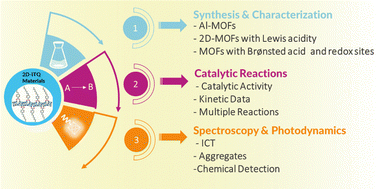Synthesis, characterization & catalysis of ITQ 2D metal–organic frameworks and spectroscopic & photodynamic properties of their composites with organic dyes
Abstract
Metal–organic frameworks (MOFs) have gained significant attention for their broad range of applications in a variety of scientific and technological fields. These materials are crystalline in nature and are formed through the self-assembly of metal ions or clusters with organic linkers via coordination bonds. Typically, MOFs adopt three-dimensional (3D) structures by assembling the subunits in all three spatial directions forming a relatively rigid network. However, in recent years, low-dimensional 2D-MOFs have garnered considerable interest due to their distinctive properties, particularly in gas adsorption/separation, sensing, catalysis, and chemical release applications. 2D-MOFs are created through the assembly of a single layer, resulting in sheet-like structures that provide larger active surface areas, thereby enhancing the diffusion of guest molecules. A notable example of this is the ITQ family of 2D-MOFs, which are formed through the assembly of 1D organic–inorganic structural subunits. The resulting mesoscopic lamellar structure of these MOFs favors interactions with organic molecules and hence improves the catalytic performance. Here, we provide a comprehensive overview of the available synthesis, structural characterization, physico-chemical properties, and specific catalytic performance of ITQ 2D MOF hybrid materials. We examine available strategies to obtain tuneable Lewis and Brønsted acid active sites from the 1D sub-domains as well as provide examples for the application of these MOFs in specific reactions. We also review studies on the effect of the nature of organic spacers as well as that of the metal clusters on the spectroscopic and photodynamical properties of composites formed by these MOFs as hosts with well-known organic fluorescent dyes (guests).

- This article is part of the themed collection: Fundamentals and Applications of Functional Framework Materials


 Please wait while we load your content...
Please wait while we load your content...